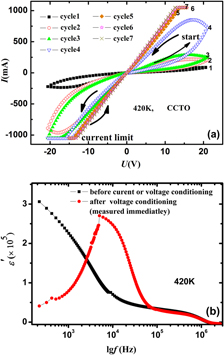Crossref Citations
This article has been cited by the following publications. This list is generated based on data provided by
Crossref.
Xu, L.F.
Qi, P.B.
Song, X.P.
Luo, X.J.
and
Yang, C.P.
2011.
Dielectric relaxation behaviors of pure and Pr6O11-doped CaCu3Ti4O12 ceramics in high temperature range.
Journal of Alloys and Compounds,
Vol. 509,
Issue. 29,
p.
7697.
Luo, Xiao-jing
Yang, Chang-ping
Song, Xue-ping
Huang, Chang
Wang, Rui-long
Xu, Ling-fang
and
Bärner, K.
2011.
Voltage dependent capacitances in CaCu3Ti4O12.
Journal of Applied Physics,
Vol. 109,
Issue. 8,
Li, Jianying
Zhao, Xuetong
Gu, Fang
and
Li, Shengtao
2012.
Defects and dc electrical degradation in CaCu3Ti4O12 ceramics: Role of oxygen vacancy migration.
Applied Physics Letters,
Vol. 100,
Issue. 20,
Zheng, Qian
Fan, Huiqing
and
Long, Changbai
2012.
Microstructures and electrical responses of pure and chromium-doped CaCu3Ti4O12 ceramics.
Journal of Alloys and Compounds,
Vol. 511,
Issue. 1,
p.
90.
Luo, Xiao Jing
Yang, Chang Ping
Song, Xue Ping
Tang, Shao‐Long
Xiao, Hai‐Bo
Bärner, Klaus Herrmann Otto
and
Varela, J. A.
2013.
Slow Relaxation Processes in CCTO Detected by Capacitance Versus Voltage Curves.
Journal of the American Ceramic Society,
Vol. 96,
Issue. 1,
p.
253.
Xu, L. F.
Cheng, T.
Wang, R. L.
Xiao, H. B.
Liu, G. Z.
and
Yang, C. P.
2014.
Microstructure and dielectric properties of Ca1–3/2xBixCu3Ti4O12 (x = 0, 0.05, 0.10, 0.15 and 0.20) ceramics.
Journal of Materials Science: Materials in Electronics,
Vol. 25,
Issue. 2,
p.
817.
Shi, Da-Wei
Yang, Chang-Ping
Chen, Shun-Sheng
Wang, Rui-Long
Xiao, Hai-Bo
Yang, Fu-jun
and
Bärner, K.
2014.
Influence of grain boundaries on the EPIR effect in Nd0.7Sr0.3MnO3 ceramics.
Journal of Alloys and Compounds,
Vol. 587,
Issue. ,
p.
659.
Wu, M. L.
Yang, C. P.
Shi, D. W.
Wang, R. L.
Xu, L. F.
Xiao, H. B.
and
Baerner, K.
2014.
Electric-pulse-induced resistance switching effect in the bulk of La0.5Ca0.5MnO3 ceramics.
AIP Advances,
Vol. 4,
Issue. 4,
Shi, Dawei
Yang, Changping
Wu, Meiling
Xu, Lisha
Ding, Yimin
Yang, Fujun
Xiao, Haibo
Wang, Ruilong
Bärner, K.
and
Marchenkov, V.V.
2015.
Influence of oxygen vacancy deep trap levels on the EPIR effect in La0.5Ca0.5MnO3 ceramics.
Ceramics International,
Vol. 41,
Issue. 6,
p.
7276.
Zhao, Xuetong
Liao, Ruijin
Zhang, Junyan
Wang, Feipeng
and
Li, Jianying
2015.
Influence of DC degradation on the dielectric response of CaCu<inf>3</inf>Ti<inf>4</inf>O<inf>12</inf> Ceramics.
p.
140.
Zhao Xue-Tong
Liao Rui-Jin
Li Jian-Ying
and
Wang Fei-Peng
2015.
Effect of direct current degradation on dielectric property of CaCu3Ti4O12 ceramic.
Acta Physica Sinica,
Vol. 64,
Issue. 12,
p.
127701.
Yang, J.
Yang, C.P.
Luo, X.J.
Shi, D.W.
Xiao, H.B.
Xu, L.F.
and
Bärner, K.
2016.
Complex permittivity and relaxation processes in CaCu3Ti(4−)Mn O12.
Ceramics International,
Vol. 42,
Issue. 9,
p.
10866.
Yang, Longhai
Chao, Xiaolian
Yang, Zhao
Zhao, Nan
Wei, Lingling
and
Yang, Zupei
2016.
Dielectric constant versus voltage and non-Ohmic characteristics of Bi2/3Cu3Ti4O12 ceramics prepared by different methods.
Ceramics International,
Vol. 42,
Issue. 2,
p.
2526.
Zhao, Xuetong
Ren, Lulu
Liao, Ruijin
Li, Jianying
Yang, Lijun
and
Wang, Feipeng
2016.
Role of Relaxation on the Giant Permittivity and Electrical Properties of CaCu3Ti4O12 Ceramics.
Journal of Electronic Materials,
Vol. 45,
Issue. 6,
p.
3079.
Tsuji, Kosuke
Chen, Wei-Ting
Guo, Hanzheng
Lee, Wen-Hsi
Guillemet-Fritsch, Sophie
and
Randall, Clive A.
2017.
Contrasting conduction mechanisms of two internal barrier layer capacitors: (Mn, Nb)-doped SrTiO3 and CaCu3Ti4O12.
Journal of Applied Physics,
Vol. 121,
Issue. 6,
Zhao, Xuetong
Ren, Lulu
Yang, Lijun
Li, Shuai
Liao, Ruijin
Li, Weiwei
and
Li, Jianying
2017.
Structure and dielectric relaxations of CaCu3Ti4O12 ceramics by heat treatments in different atmospheres.
IEEE Transactions on Dielectrics and Electrical Insulation,
Vol. 24,
Issue. 2,
p.
764.
Sun, Kang
Xu, Ling-Fang
Mao, Cong
Feng, Xing
Liang, Jia-Yu
Xiao, Hai-Bo
Wang, Rui-Long
Shi, Da-Wei
and
Yang, Chang-Ping
2017.
Preferential orientation and relaxation behaviors of CaCu3Ti4O12 thin films in a low frequency range.
Journal of Alloys and Compounds,
Vol. 704,
Issue. ,
p.
676.
Xu, Chao
Zhao, Xuetong
Ren, Lulu
Sun, Jianjie
Yang, Lijun
Guo, Jing
and
Liao, Ruijin
2019.
Enhanced electrical properties of CaCu3Ti4O12 ceramics by spark plasma sintering: Role of Zn and Al co-doping.
Journal of Alloys and Compounds,
Vol. 792,
Issue. ,
p.
1079.
Cho, Seongkoo
Chiu, Tse-Ming
and
Castaneda, Homero
2019.
Electrical and electrochemical behavior of a zinc-rich epoxy coating system with carbon nanotubes as a diode-like material.
Electrochimica Acta,
Vol. 316,
Issue. ,
p.
189.
Luo, X.J.
Zhang, Y.T.
Xu, D.H.
Chen, S.S.
Wang, Y.
Chai, Y.
Liu, Y.S.
Tang, S.L.
Yang, C.P.
and
Bärner, K.
2019.
Origin of the temperature stability of dielectric constant in CaCu3Ti4O12.
Ceramics International,
Vol. 45,
Issue. 10,
p.
12994.





